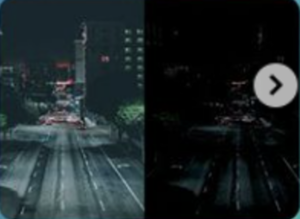If you look carefully at the blue sky in mid-picture between the clouds, you will a bunch of wispy white threads. They look like they are wisps of cloud and are up in the sky and they are often best seen against a blue background but they aren’t cloud wisps – they are in the cornea of your eye.
These black wisps are what most of us would call floaters. We might have one or two swim across our vision from time to time but never as many as this. When we have one or two floaters, ophthalmologists can look into our eyes and see them. When we have lots like this, they can see none of them.
While our right hands have known for over a century roughly what might be going on, our left hands figure that because the floaters can’t be seen they are all in our minds, or our mind’s eye, or maybe in our brains rather than actually somewhere in our eyes. We are being told we are imaging them, that we have a psychological rather than an ophthalmological issue.
But these wisps are entoptic – in the eye. The cornea is a good bet. Retinas are the other option. The folks who can’t see what is going on tend to be eye experts.
Under certain conditions, such as illuminating the cornea from the side we can all see something like these wisps. Our cornea is densely packed with nerve fibres and blood vessels, yet somehow we seem to see through this normally without interruption. Change the angle of illumination and we can see blood cells or platelets squeezing through tiny vessels and these are the wisps we are seeing.
This in its own right is weird but equally weird is the likelihood of ophthalmologists deciding we have a nervous problem. an anxiety disorder, which these days they call a functional nervous disorder, code for hysteria. They suggest treatment with an SSRI, even when the problem has started while we have been on or just withdrawn from an SSRI. Or they may suggest psychotherapy to unearth buried trauma.
This is the Weird part of some of the things that happen our vision when we take SSRIs that your reports to RxISK have made us aware of. We have tried to bring these to the attention of ophthalmologists but for the most part they simply do not want to know – they go into shoot the messenger mode, or hold up the garlic and crucifix etc.
All of these problems and the medical response to them is worth paying heed to, even if you have no visual problems linked to your meds, as they shed increasing light on the effects of Antidepressants in general, especially their effects when we try to withdraw from them and they also point to the problems of increasing specialization within medicine.
The Eyes Have It
This Visual Weird post follows on from the two Visual Snow and Visual Blur and Retinal Detachment and Antidepressants and much earlier Keeping your Eye on Ball posts.
We shouldn’t really be in such a weird world with no-one able to account for strange visual effects. After all we have known for 70 years that LSD, which also acts on the serotonin system, produces an explosion of and intermingling of sensory effects. But as with SSRIs now, LSD’s effects have also mostly been handled by invoking brain serotonin systems rather than eyes, although comparatively, for their size, there is far more serotonin in our eyes, especially in our retinas and corneas than in the brain. There are definitely many more PIEZO proteins in our eyes than our brains – see below.
A related reason for being slow to recognize the role of serotonin in eyes is that for half a century when it comes to psychiatric drugs both ophthalmologists and psychiatrists have had another whipping boy – drugs with anticholinergic effects. See Psychotropic Drug Follies, The Marketing of Anticholinergic Maleficence, Experts by Experience and Withdrawal, PSSD and Anticholinergic Drugs.
In the 1960s it quickly became an article of faith that strong serotonin reuptake inhibitors like imipramine, amitriptyline and clomipramine caused dry eyes, glaucoma and visual blurring because of their anticholinergic effects. If things went wrong with your eyesight on these drugs, you were told not to get your glasses changed – wait till you come off the treatment. That was back when we only expected you to be on an antidepressant for 3-6 months.
There is very little evidence that pure anticholinergic drugs, or anticholinergic antihistamines, cause problems like these and increasing evidence that drugs active on the serotonin system cause dry eyes, glaucoma and especially blurred vision.
Trust the Messenger
Both I, and I’m sure any medics reading RxISK posts, learn more from input through emails and comments from you than we give to you in exchange – except in so far as we pass your comments on to others.
SSRIs definitely interfere with blink rate, which is important for how dry your eyes are. Dry eyes is a major complaint on antidepressants previously put down to anticholinergic effects. Anticholinergic drugs in fact increase blink rate.
Anticholinergics like cyclizine or oxybutynin may help relieve some of the visual problems SSRIs cause – it would be great if anyone has noticed anything in this area could comment or email.
This comment on the Retinal post is also interesting:
On Mirtazapine I had very dry gritty eyes and they felt under pressure so I went and had them checked and they said I needed to be referred to an NHS optician because my pressure was above normal limits. I asked to wait for a month to see if coming off mirtazapine would make a difference and it did my eye pressure went back to normal levels.
On paroxetine I fluctuated between dilated pupils and constricted pupils. On citalopram I had constricted pupils. I only noticed the dry, gritty and pressure feeling on Mirtazapine.
Mirtazapine also acts on the serotonin system although not in the same way as SSRIs but can end up causing very similar problems.
There was another comment on the retinal post, which a second comment from another person endorsed as very accurate. Light sensitivity like this is perhaps the same as what is often called photophobia – which SSRIs definitely trigger.
From ages 18-21 I was getting progressively worse vision. I didn’t notice it until it got to a level where I was having intense blurriness, very bad light sensitivity and this hard to explain feeling of pressure/tension from the back of my eyes that was very uncomfortable. I am farsighted and have always needed glasses for reading close up, like for reading text on my phone but this was a different kind of blurriness that was much worse than the kind you get if you don’t wear glasses, it’s like my eyes just couldn’t process what was in front of me, they felt like they were giving up as soon as I started reading a sentence and they couldn’t keep track of what I was trying to read.
The light sensitivity was intense, I remember a bright summers day and I was with my friends and they were all normal and I was there shielding my eyes with my hands, squinting etc.
The pressure/tension feeling was absolutely vile, it’s such a hard feeling to explain but it felt like my eyes were ‘gritty’ and it’s how I’d imagine inflammation to feel like. The Keeping an eye on the ball post offered a explanation because prior to that I had been to many high street opticians and even has a comprehensive examination with an ophthalmologist, and nothing was ever found to be abnormal. They all said my eyes were perfectly healthy. Even my glasses prescription didn’t change. This is such an isolating experience because you know something is wrong but nobody knows what. I started to think I may have some rare neuro degenerative disease affecting my eyes that nobody could detect. I was going insane.
Go Ask Alice
A series of emails from someone who has reported a mixture of visual snow and blur also mapped on to the difficulties with computer screens noted in this last comment. This person had headaches with his visual problems which were diagnosed as Migraine. This diagnosis led to anticonvulsant treatment, a standard treatment for migraine. He had had most of the available anticonvulsants without any benefit for his visual effects except when he took Topiramate – Topamax.
His response to Topiramate was eye-catching. Why would Topiramate work when other anticonvulsants didn’t? Why would the anticonvulsant usually fingered as the one most likely to cause side effects seem to help some side effects clear up? Why would a drug notable for causing visual effects like Alice in Wonderland Syndrome – See Go Ask Alice – help some visual problems caused by SSRIs clear up?
The Go Ask Alice post is worth a read – it outlines a strange set of visual distortions that among other things can be labeled Alice in Wonderland Syndrome in one country and Hallucinations in another.
Most anticonvulsants block sodium currents, or act on GABA or do both. Topiramate blocks sodium currents and acts on GABA and in addition is a Carbonic Anhydrase Inhibitor – a CAI. CAIs can reduce fluid production in eyes and other tissues around the body.
Why is this significant? SSRIs are Carbonic Anhydrase Activators. SSRIs increase fluid, which increases pressure in the eyeball. This increased pressure can affect the retina and looks like the way SSRIs cause glaucoma – which CAIs can treat.
Topiramate is a CAI. The best known CAI is acetazolamide – brand name Diamox. Acetazolamide is used for migraine, epilepsies, altitude sickness, and periodic paralyses. Interestingly it also seems useful for Pre-Menstrual Dysphoric Disorder (PMDD) – severe PMT – especially when SSRIs don’t help.
My email correspondent reports that Topiramate seems to help the Visual Snow more than the Visual Blur features he has. He hopes to try acetazolamide in place of topiramate and will report back.
Weird Effects
SSRI induced visual effects also bring PIEZO proteins into view. Discovered a decade ago, so pretty new, these first appeared in posts about PSSD. They are the best candidate at present to explain the enhanced touch we call erotic touch as opposed to just ordinary touch sensation – See New Test to Confirm PSSD Diagnosis.
PIEZO proteins are mechano-sensory receptors – if the touch of a hand or the touch of food in a stomach stretches things PIEZOs sense the stretch. The sense of stretch is not usually listed as one of our senses but is critical to knowing when we are full or need to pass a bowel motion or empty a bladder, as well being linked to pain when inflamed tissues are stretched.
PIEZOs are closely linked to the serotonin system in the gut, bladder and skin. When they disconnect or fail to function, they may underpin the kind of change that gives rise to PSSD. The opposite effect on PIEZO proteins might fit the bill for explaining PGAD with orgasms triggered at the slightest vibration or touch.
PIEZO proteins are found in corneas and retinas. They are likely the way we sense increased eyeball pressure – linked to SSRIs. They seem good candidates to explain how there might be an extreme sensitivity to light in some of us, as noted above, and the inability others have to cope with low light as found in nyctalopia.
Dreaming
The next point may seem like a longer shot but there is likely some interface between vision and dreaming. In both cases we see images. One of the features of SSRI intake and SSRI withdrawal is that some people can be left plagued by vivid and violent dreams, sometimes called lucid or waking dreams, while others can have Aphantasia – a complete absence of imagery – triggered by SSRIs that can coincide with PSSD.
This is one more feature of SSRI effects – they can have directly opposite effects from person to person. When the first appeared, in Listening to Prozac Peter Kramer raved about them transforming homosexuals into heterosexuals but we now know that just the opposite can happen also. It’s almost as though serotonin sits at the middle of a seesaw – this or that seat can up or down.
Last week’s post asked for people to try lithium. This weeks suggests trying acetazolamide and either cyclizine or oxybutynin. Both lithium and acetazolamide eliminate excess fluids – so there is some overlap in possible effects.
These suggestions are not just for people with visual problems linked to their medicines but also folk with sexual, gut and other problems. There may be no connection between the problems SSRIs can cause in different systems but we need to establish this. Any links there might be would help move everything forward.
Next week’s post will hopefully contain some striking surprises that comes from leads from your input.



tim says
This has been truly fascinating. A masterclass in pharmacology. Thank you.
annie says
BLINK and you’ll miss it…
Some considerable time went in to this study –
Finally, it is unclear the extent to which between-groups differences in blink rate were influenced by medication usage in the bipolar group: although group differences remained non-significant when controlling for medication dosage, correlational analyses suggest that some degree of variability in blink rate is associated with medication dosage.
https://www.ncbi.nlm.nih.gov/pmc/articles/PMC4886748/
On Seroxat withdrawal, I was aware of hardly blinking.
I would stare in to space. My eyes were not alive. When I had been tempted outdoors, after weeks in our bedroom, curtains drawn, against the light, a paper was flapped right in front of my eyes. Staring straight ahead, I did not blink.
When you do not blink your eyes are not nourished, they dry out, your tear ducts are not doing what they are supposed to do.
I had many conversations with opticians about how one minute my eyes were swimming with water and the next minute dry as a bone.
When the first optician told me I had AMD, it was so brutal, I thought I would wake up blind. After going private, to save my sight, I said at a recent eye test, that I thought it was quite frightening when given an AMD diagnosis and the optician looked at me as if I was quite mad.
Also, after the implants, when the surgeon, said I would only need magnifying glasses of 1.5 magnification to read, the optician said, no, you need prescription glasses for reading. I knew I didn’t and went along with it as she was quite cross. I went for £100 for two pairs of prescription glasses, to appease her, and what do you know, my two eyes do not compute together as per her prescription, and although her tests deemed otherwise, I do so much better with magnification of 1.5 for both eyes.
I need my driving licence, so I need my Optician.
Swept again in to the ‘Weirdness’ …
Anne-Marie says
This is a really interesting post especially about the floaters. I think ive experienced transparent floaters but i could see the outline to the shape. I don’t recall when I’ve seen them or whether my eyes where open or shut but I do have a faint distant memory of seeing them in the past.
Kate B-T says
New York Times article from today reported that Luigi Mangione has visual snow. Also has brain fog, IBS, and possible chronic Lyme disease. The visual snow makes me even more curious about the possible role of psych meds in his murder (we await learning if he was on them).
https://www.nytimes.com/2024/12/12/us/luigi-mangione-gunman-united-healthcare-shooting.html
Dr. David Healy says
K
Anything anyone can find would be fascinating to get
D